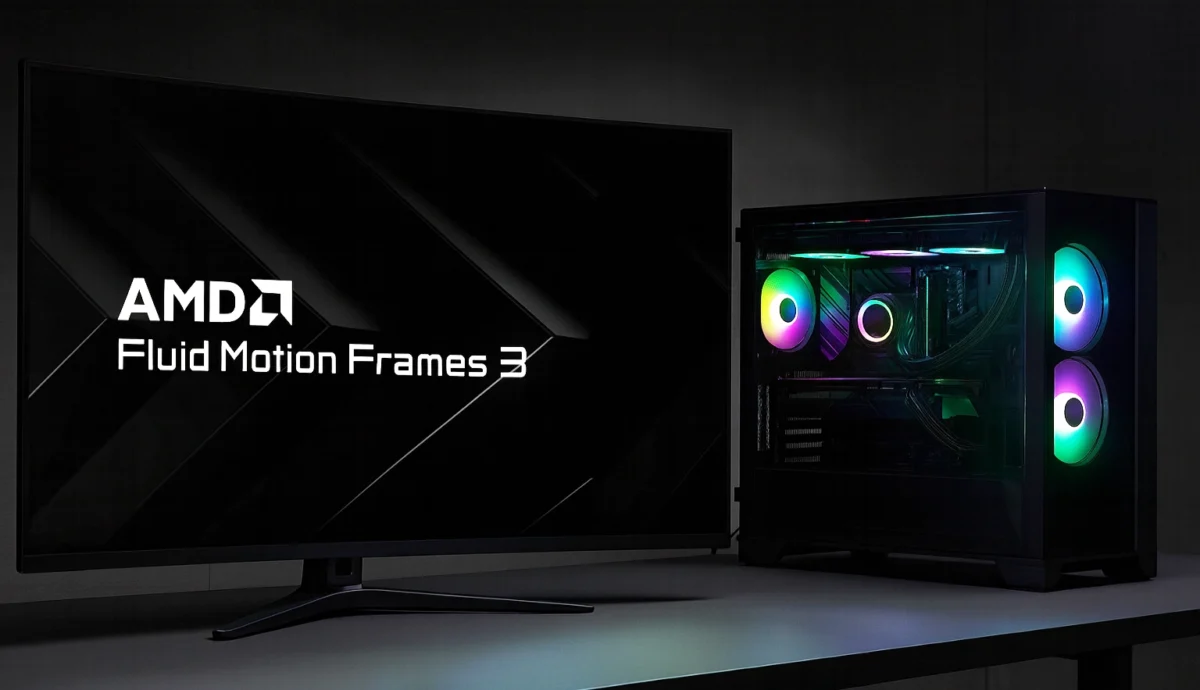AMD’s latest Radeon driver files have revealed references to Fluid Motion Frames 3 (AFMF 3), suggesting that a major update to its frame-generation technology may soon arrive. According to Club386, the leak hints at new features built on AMD’s previous driver-level interpolation system. But while the idea of smoother gameplay sounds promising, gamers remain cautious about latency, artifacts, and real-world performance.
What Is Fluid Motion Frames?
AFMF is AMD’s system for generating extra frames in real time by inserting interpolated images between rendered ones. Unlike NVIDIA’s DLSS Frame Generation, which requires game-level support, AFMF works at the driver level, applying across DirectX and Vulkan titles without developers needing to modify code. AMD describes it as part of its Radeon Adrenalin software ecosystem (AMD official page).
The second-generation AFMF 2.1 introduced improvements in image stability and latency, as highlighted by The Verge, and extended support to more games. The leaked AFMF 3 could mark the next big leap.
The AFMF 3 Leak: What We Know
Driver update data files contained code strings mentioning “FrameGenV3” and AFMF 3, as spotted by Overclock3D. While AMD has not officially announced it, the presence in public driver builds suggests development is advanced.
Speculated improvements include:
- Better artifact handling through AI-driven motion prediction
- Reduced ghosting compared to AFMF 2.1
- Integration with FSR enhancements for more stable visuals
- Possible hardware restrictions tied to RDNA 4 GPUs
Still, leaks don’t guarantee release features — AMD could hold back or alter AFMF 3 before launch.
Promise vs. Reality
✅ Potential Benefits
- Driver-level convenience across many games
- Frame generation without developer intervention
- Potentially improved smoothness in titles lacking FSR 3
⚠️ Challenges Ahead
- Extra frames mean added latency, which can affect competitive play
- Artifacts and ghosting in fast-moving games remain a risk
- Possible hardware gating — limiting the feature to new GPUs
- Unproven real-world gains until tested outside labs
As Tom’s Hardware notes, gamers should view AFMF 3 with cautious optimism until benchmarks are available.
How Might AFMF 3 Work?
The foundation of AFMF is optical flow — estimating pixel movement between frames and generating an intermediate image. According to Wikipedia’s AMD Software entry, Fluid Motion Frames relies on temporal interpolation techniques similar to those used in video playback smoothing.
AFMF 3 may extend this with:
- AI-enhanced motion analysis
- Temporal blending to reduce flicker
- Adaptive quality modes balancing smoothness and clarity
If these refinements work as intended, AFMF 3 could reduce the compromises that hurt previous iterations.
Frequently Asked Questions (FAQs)
Q1: Will AFMF 3 cause more input lag?
Yes, like all frame-gen tech, it introduces some delay. AMD’s challenge is making it subtle enough that most players won’t notice.
Q2: Which GPUs will support AFMF 3?
Leaked code suggests newer Radeon GPUs (possibly RDNA 3 and RDNA 4) will benefit most, but official support hasn’t been confirmed.
Q3: How is AFMF different from FSR 3?
FSR 3 requires game-level support and motion vectors, while AFMF runs at the driver level, injecting frames into any supported game.
Conclusion
AFMF 3 could be a valuable tool for boosting frame rates in unsupported games, but gamers should temper expectations. Until AMD officially unveils the feature — and reviewers test it — the leak remains just that: a hint of what’s to come.
Key Takeaway: Fluid Motion Frames 3 may promise smoother gameplay, but only real-world performance will determine if it’s an upgrade or just another experiment.
Last Updated on October 18, 2025 by Lucy




